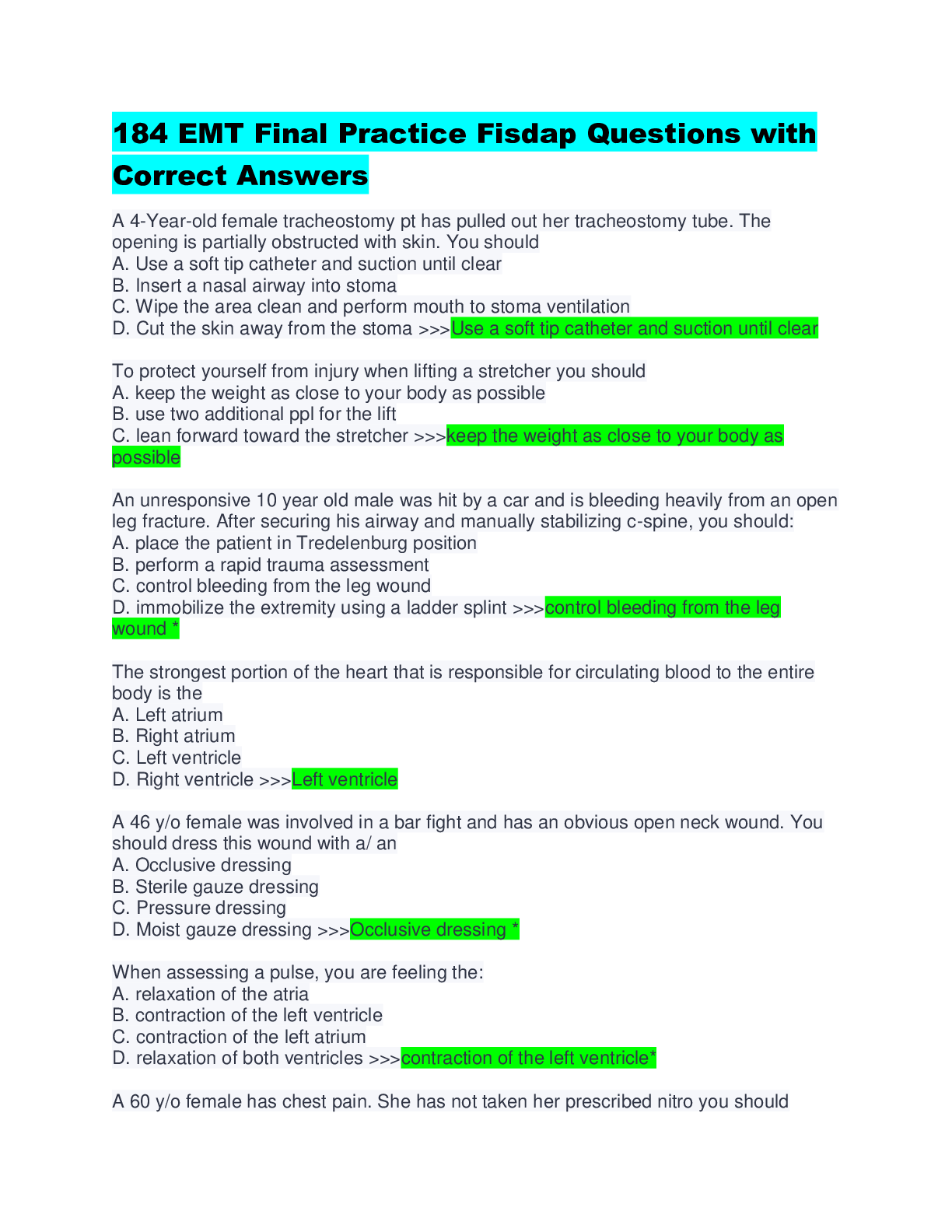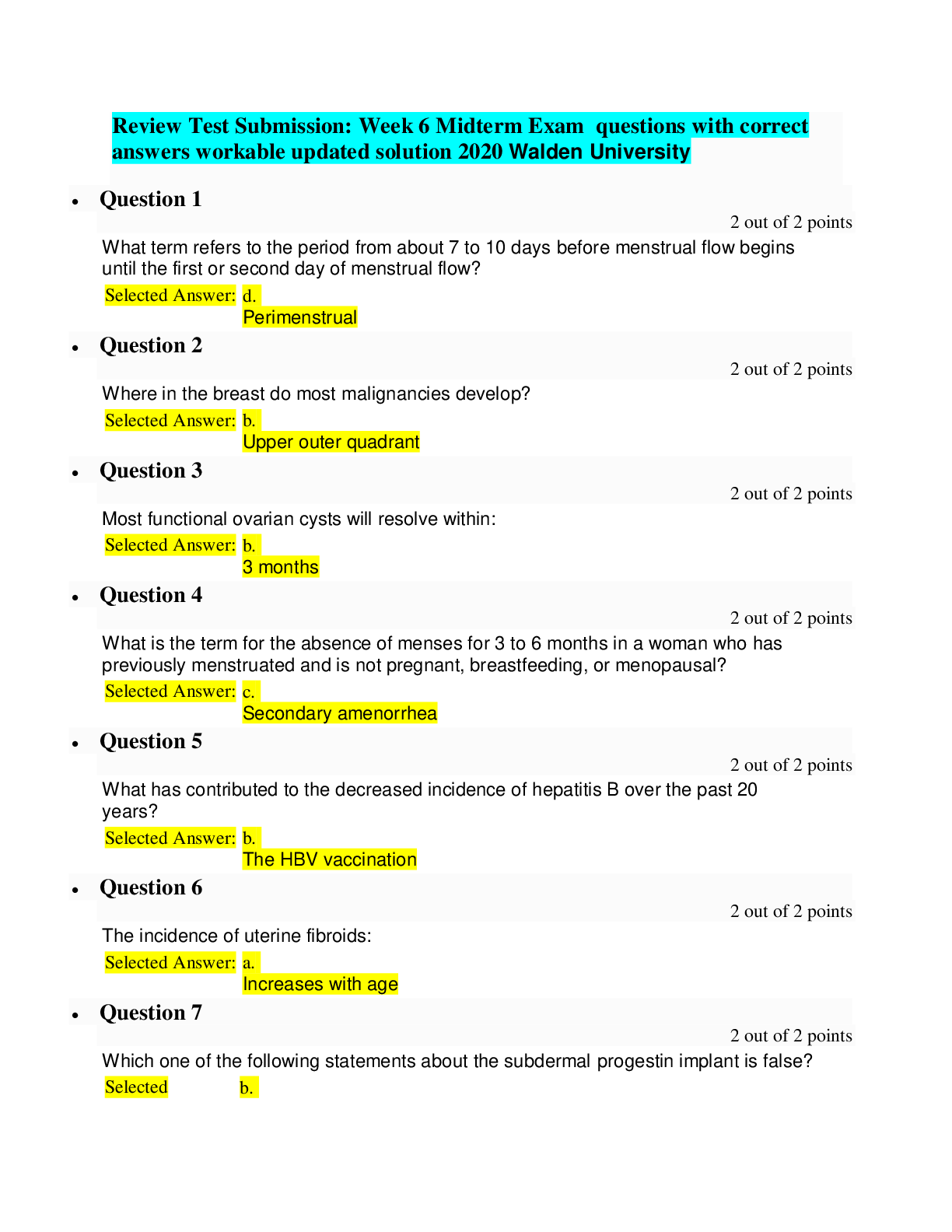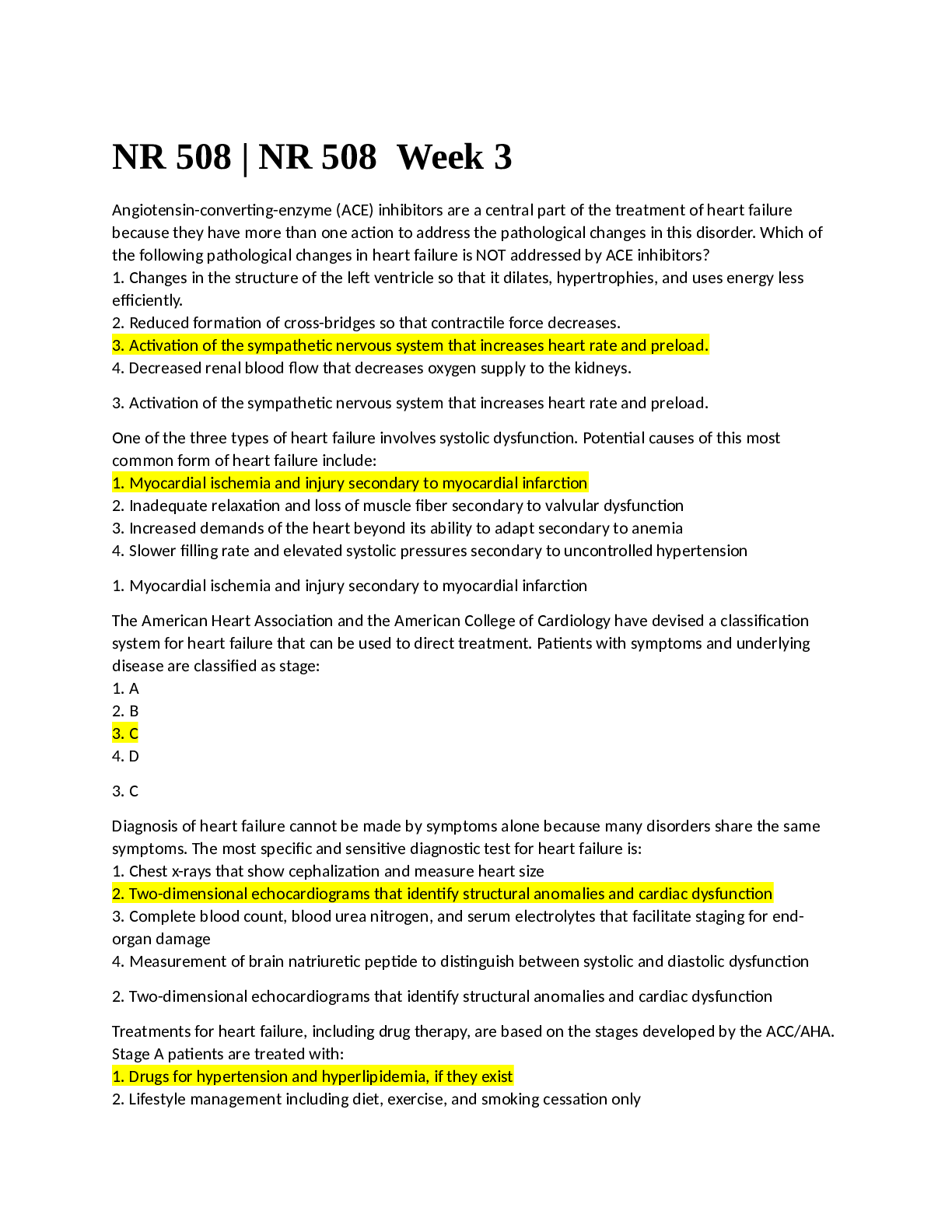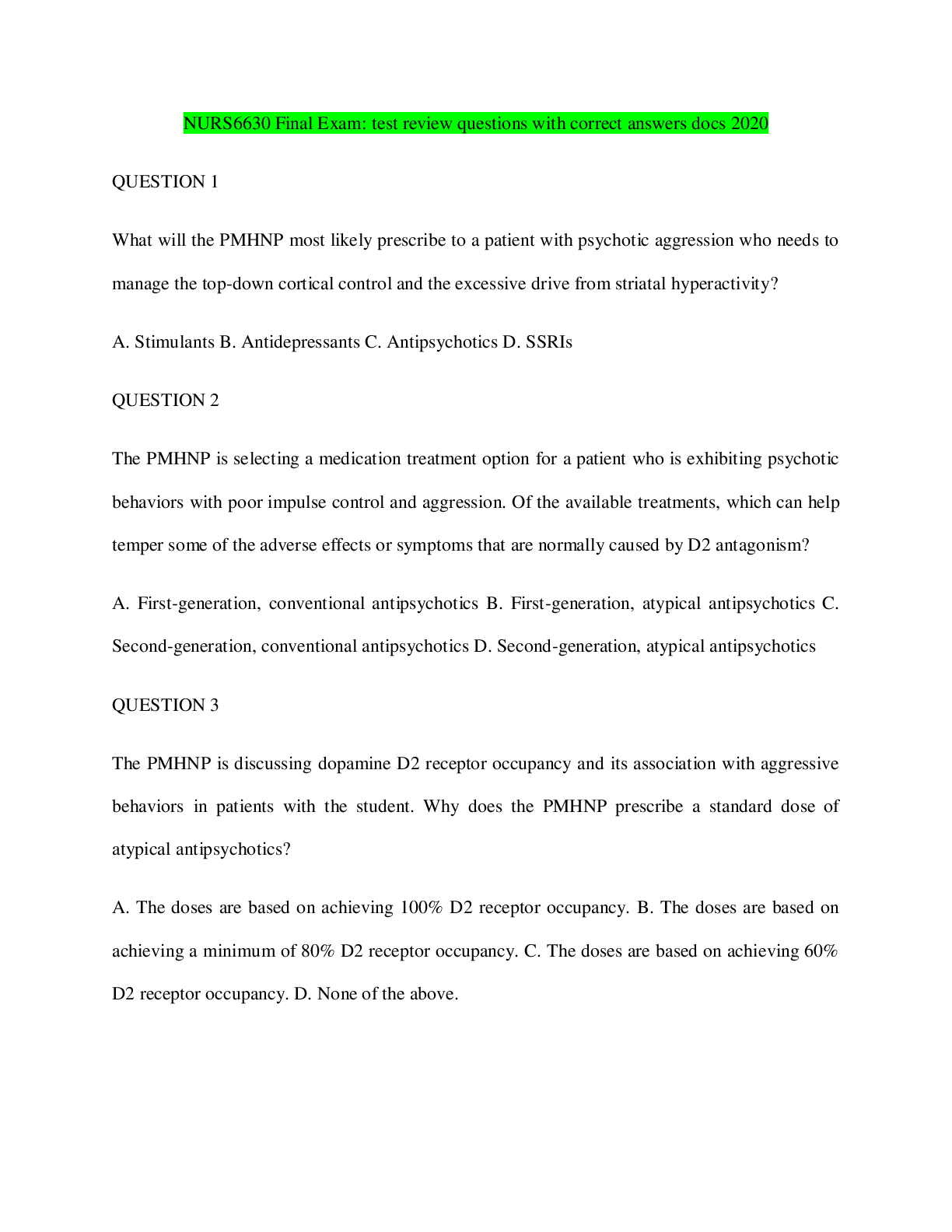*NURSING > QUESTIONS & ANSWERS > 184 EMT Final Practice Fisdap Questions with Correct Answers. Rated A. 2022/2023 (All)
184 EMT Final Practice Fisdap Questions with Correct Answers. Rated A. 2022/2023
Document Content and Description Below
184 EMT Final Practice Fisdap Questions with Correct Answers A 4-Year-old female tracheostomy pt has pulled out her tracheostomy tube. The opening is partially obstructed with skin. You should A. ... Use a soft tip catheter and suction until clear B. Insert a nasal airway into stoma C. Wipe the area clean and perform mouth to stoma ventilation D. Cut the skin away from the stoma >>>Use a soft tip catheter and suction until clear To protect yourself from injury when lifting a stretcher you should A. keep the weight as close to your body as possible B. use two additional ppl for the lift C. lean forward toward the stretcher >>>keep the weight as close to your body as possible An unresponsive 10 year old male was hit by a car and is bleeding heavily from an open leg fracture. After securing his airway and manually stabilizing c-spine, you should: A. place the patient in Tredelenburg position B. perform a rapid trauma assessment C. control bleeding from the leg wound D. immobilize the extremity using a ladder splint >>>control bleeding from the leg wound * The strongest portion of the heart that is responsible for circulating blood to the entire body is the A. Left atrium B. Right atrium C. Left ventricle D. Right ventricle >>>Left ventricle A 46 y/o female was involved in a bar fight and has an obvious open neck wound. You should dress this wound with a/ an A. Occlusive dressing B. Sterile gauze dressing C. Pressure dressing D. Moist gauze dressing >>>Occlusive dressing * When assessing a pulse, you are feeling the: A. relaxation of the atria B. contraction of the left ventricle C. contraction of the left atrium D. relaxation of both ventricles >>>contraction of the left ventricle* A 60 y/o female has chest pain. She has not taken her prescribed nitro you shouldA. Determine what type of cardiac problem the pt has, and assist her with taking the nitro B. Immediately attached the AED and begin transport to hospital C. Administer aspirin only and withhold the nitro D. Consult medical direction with regard to assisting the pt in taking the nitro >>>Determine what type of cardiac problem the pt has, and assist her with taking the nitro Which of the following is the best definition of hypoperfusion? A. Less blood reaching capillary beds B. Inadequate oxygen delivery to cells C. Lowered heart rate and BP D. Blood vessel dilation causing distal pooling >>>Inadequate oxygen delivery to cells You are ventilating an apneic asthmatic patient with a BVM, but notice there is inadequate chest rise. What should you do? A. reassess the airway for an obstruction B. increase the ventilation pressure C. switch to an O2 powered ventilation device D. increase the rate of the ventilations >>>reassess the airway for an obstruction * For which of the following patients would an OPA be most appropriate? A. A 19 y/o with a mandible fracture who is only responsive to pain B. Unresponsive 25 y/o with a suspected spinal injury C. Unresponsive five-year-old with a suspected airway obstruction D. Semiconscious 76 y.o old who is gasping for air >>>Unresponsive 25 y/o with a suspected spinal injury Your patient is pale, diaphoretic, and complains of chest pressure. Her vitals are R 18 P 58, and BP 88/50. You should suspect A. Unstable angina B. A thoracic aneurysm C. Cardiogenic shock D. Pulmonary embolism >>>Cardiogenic shock A 66 y/o male is confused. He has a history of substance abuse and falls. His breath smells of alcoholic beverage. He is alert and refusing service. You should A. Obtain consent from his family and transport B. Document his refusal and recommend that he see his doctor C. Speak calmly to him and convince him to accept transport D. Have the police transport the pt to detox unit >>>Speak calmly to him and convince him to accept transport Your 12 yr old patient has a penetrating wound to the abdomen. You may provide care based on A. informed consentB. expressed consent C. implied consent >>>implied consent A victim of smoke inhalation has developed difficulty breathing. He does not like the smell of the mask you are using to deliver O2. You should A. Switch to a NC set to deliver O2 @ 6 LPM B. Restrain the pt and continue administering O2 via NRB C. Explain that the mask is very important and continue its use D. Administer blow-by O2 via Simple mask >>>Explain that the mask is very important and continue its use A 23 y/o construction worker twisted his foot climbing up a ladder. He has an obvious deformity on the right leg just below the knee. The lower leg and foot are cyanotic and pulseless. You should A. Apply an air splint and transport B. Apply spinal immobilization and elevate the leg C. Pull gentle traction and apply a splint D. Apply a traction splint and transport >>>Pull gentle traction and apply a splint Which of the following is TRUE about the insertion of an OPA? A. the OPA is always rotated 360 degrees as it is inserted B. if properly inserted, the OPA will keep the tongue out of the way C. the OPA should be inserted until the flange rests below the patient's teeth >>>the OPA should be inserted until the flange rests below the patient's teeth* While ventilating a near drowning pt, you suddenly feel increased resistance in the airway. You should A. Perform abdominal thrust B. Place pt in lateral recovery position C. Attempt to reposition the head D. Apply firm pressure to the abdomen >>>Attempt to reposition the head A 28 y/o female who is 12 weeks pregnant has twisted her left knee while walking. She states the pain is 10/10 in severity. You should A. Apply a traction splint and immobilize with a long spine board B. Transport on her left side and hold manual stabilization until she gets the hospital C. Splint with the stretcher and straps and transport her on her left side D. Splint using board splints and cravats and transport sitting >>>Splint using board splints and cravats and transport sitting A 20 yr old female complains of severe abdominal pain. She is in the fetal position. After your primary assessment, you should A. transport immediately to hospital B. palpate all 4 quadrants of abdomen C. obtain baseline vital signs >>>obtain baseline vital signs*An intoxicated 33 y/o female was fighting with police. You note some minor scrapes on the pt's leg and face. The pt is being verbally abusive to you. The police want your approval to take the pt to jail. You should A. Ask the officer to transport her to the hospital in a squad car for safety B. Request that the officers arrest the patient prior to transport C. If vital signs are within normal limits, release the pt to the police D. Restrain and transport the pt with police escort >>>Restrain and transport the pt with police escort First responder has delivered a baby. The infant is blue and lethargic; the pulse is 90 you should A. Transport after placenta is delivered B. Dry, stimulate and apply oxygen C. Transport and administer CPR enroute D. Transport to closest hospital >>>Dry, stimulate and apply oxygen A patient has been kicked in the chest. One section of ribs is moving separately during respirations. You should A. Transport emergently B. Listen for lung sounds C. Initiate PPV D. Place a sandbag on the injury >>>Initiate PPV A 56 y/o male is complaining of severe CP. He took Viagra two hours ago and has been physically active. You should A. Assist the pt in taking his nitro and apply O2 B. Administer O2 and request an ALS intercept C. Monitor vitals, if BP is above 100 systolic, administer nitro and apply oxygen D. Assure an open airway and continue gathering history >>>Assure an open airway and continue gathering history You're transporting a 62 yr old patient complaining of chest pain. Vital signs are: BP 88/40, P 90, R 12. Online medical control orders you to assist the patient in taking his prescribed nitro. You should A. check the expiration date then administer the nitro B. assist the patient w/administering his nitro C. repeat the vital signs and confirm the order >>>repeat the vital signs and confirm the order * Which of the following is the build-up of fatty deposits on the inner walls of an artery? A. Coronary artery disease B. Thrombus C. Aneurysm D. Atherosclerosis >>>AtherosclerosisA 60-year-old pt with stoma is apneic. You have been suctioning pink frothy sputum for 10 seconds and you continue to get more material. You should A. continue suctioning and have a partner ventilate through the pt's mouth B. suction until airway is clear C. stop suctioning and give a breath D. use a saline solution to moisten secretions and continue suctioning >>>stop suctioning and give a breath A pulseless and apneic 68 year old male has an implanted pacemaker in his right shoulder Without delaying defibrillation, where should you apply the AED pads? A. anterior chest and back (between shoulder blades) B. nipple line under the left and right armpits C. left shoulder (to avoid pacemaker) and lower right chest D. right shoulder (directly over the pacemaker) and the left lower chest >>>anterior chest and back (between shoulder blades) You are transporting a patient who has been restrained due to hostile behavior. He is complaining that he has no feeling in his hands and is threatening to sue you if you don't remove the restraints. You should: A. place padding between the restraint and the patient's skin B. loosen the restraints C. assess the patient's distal circulation frequently D. remove the restraints >>>assess the patient's distal circulation frequently* During a birth the baby's head was delivered. You should: A. suction the mouth and nose with a bulb syringe B. insert a Delee suction catheter in the mouth C. suction the mouth only with a bulb syringe D. suction for 15 seconds with a pediatric suction device >>>suction the mouth and nose with a bulb syringe* Your patient is a 65 year old male complaining of chest pain. Which of the following would be a contraindication for assisting with the administration of sublingual nitroglycerin? A. Heart rate >100 B. Heart rate <100 C. SBP >100 D. SBP <100 >>>SBP <100 What are the two manual methods of opening a patient's airway? A. head tilt-chin lift and jaw thrust B. head tilt-chin lift and nasopharyngeal airway C. jaw thrust and finger sweep D. head tilt-chin lift and oropharyngeal airway >>>head tilt-chin lift and jaw thrustYour patient is in labor. As the baby's head delivers, you notice the amniotic sac has not broken. You should: A. use your gloved finger to puncture the membrane B. place mom on her knees to take the pressure off the sac C. place mom on O2 to prevent fetal distress D. have mom pant >>>use your gloved finger to puncture the membrane A conscious 7 year old patient has chemical burns around her mouth from ingesting drain cleaner. Her breathing is adequate. You should: A. evaluate the patient's airway B. flush burns with water C. contact medical control D. administer activated charcoal >>>Contact medical control Your patient is allergic to bee stings. She suddenly began having watery eyes and itching in her arms. She does not remember being stung. Vital signs: BP 130/80, P 110, R 16. You should: A. apply O2 and transport B. monitor airway, encourage family to transport C. attempt to find the stinger and remove it immediately D. assist the patient in self-administering her Epi-pen >>>apply O2 and transport* A 45 year old male farmer has been working with dry lime. The patient has large amounts of this powder on both legs. You should: A. gently brush off excess powder and transport B. use vinegar to dilute and transport C. wash off the powder with water and transport D. use milk to dilute >>>gently brush off excess powder and transport An unbelted driver struck a tree with his vehicle. Upon examination of the chest you see bruising to the right side. Your initial vitals are BP 88/76, P 128, R 20. You should suspect: A. liver laceration B. cardiac tamponade C. neurogenic shock D. multiple rib fractures >>>cardiac tamponade Five minutes after delivery of a newborn, your patient is moving all extremities, has pink sin, a weak cry, is grimacing and has a pulse of 96. The APGAR score is A. 10 B. 6 C. 8 D. 4 >>> When responding to an incident involving an unidentified hazardous material, the most appropriate place to position the ambulance is:A. downwind and uphill B. downwind and downhill C. upwind and uphill D. upwind and at the level of the incident >>>upwind and uphill A 30 year old male has been struck by a car. You note a contusion and pain to his left hip. There is no crepitous on exam. Vital signs are: BP 110/60, P 72, R 12; You should suspect: A. ecchymosis B. fractured pelvis C. neurogenic shock D. long bone contusion >>>fractured pelvis A patient with chest discomfort becomes unresponsive during transportation to the hospital. What is the most appropriate action? A. start CPR while you assess for pulselessness and apnea, then apply AED and shock if necessary B. stop vehicle, confirm pulselessness and apnea, apply an AED, and shock if necessary C. confirm pulselessness, apply an AED, and advise partner to drive vehicle emergently D. confirm pulselessness, initiate CPR, stop the vehicle and apply an AED >>>confirm pulselessness, initiate CPR, stop the vehicle and apply an AED** Which of the following statements regarding suctioning of an adult is true? A. you should insert the suction catheter only as far as you can visualize B. you should start ventilations if suction cannot clear the airway C. you should only suction for a maximum of 30 seconds D. you should remove the suction catheter with the suction machine turned off >>>You should insert the suction catheter only as far as you can visualize When driving an ambulance, operators must drive with the safety of others in mind. This is known as driving: A. defensively B. with privileges C. with due regard D. offensively >>>with due regard A patient is in respiratory distress after eating soup brought by her neighbor. Her neighbor states "She was eating and suddenly her throat got tight." She is sitting bolt upright in a tripod position. You should suspect A. Anaphylaxis B. Choking C. Emphysema D. Asthma >>>AnaphylaxisA 23 y/o patient is lethargic. The patient just finished mowing the lawn. He is drooling and sweating profusely. You should suspect A. Hyperglycemia B. Hypoglycemia C. Heat stroke D. Intoxication >>>hypoglycemia Your 18-mo. old pt has pale cool skin, decreased mental status, and delayed cap refill. The mother tells you that the child's diaper has been dry for most of the day. First responders have applied oxygen. You should A. position the child on his side and transport B. rapidly transport and monitor vital signs C. ventilate with BVM and transport rapidly D. transport rapidly and apply wet towels enroute >>>rapidly transport and monitor vital signs After delivering a shock with an AED the patient begins to move and speak. You should A. begin BVM ventilations B. immediately remove AED pads to avoid accidental shock C. perform a sternal rub to assess LOC D. assess vital signs and begin transport >>>assess vital signs and begin transport You should ventilate a newborn once every: A. 4 seconds B. 2 seconds C. 3 seconds D. 5 seconds >>>3 seconds What is the amount of air moved with one normal breath called? A. minute volume B. tidal volume >>>tidal volume Which of the following is the most appropriate way to measure for an oropharyngeal airway adjunct? A. From the patient's earlobe to angle of the jaw B. From the center of pt's mouth to earlobe C. From the corner of the pt's mouth to the earlobe D. From the tip of pt's nose to earlobe >>>From the corner of the pt's mouth to the earlobe Your patient has spilled a dilute alkali solution into his eyes. You should first A. irrigate with clean water B. cover both eyes and transport C. cover the affected eye and transport D. irrigate with dilute ammonia >>>irrigate with clean water *Your patient has a fork impaled into his cheek. He is having trouble breathing. You should A. carefully remove the fork from his cheek B. insert a nasal airway and apply oxygen C. stabilize the fork with bulky dressings >>>carefully remove the fork from his cheek * Which of the following BEST describes a bipolar patient? A. They often have hallucinations B. They do not have a history of manic-depressive disorder C. They appear psychotic during manic phases >>>They appear psychotic during manic phases A 2 year old conscious and alert patient has ingested an un [Show More]
Last updated: 1 year ago
Preview 1 out of 29 pages

Buy this document to get the full access instantly
Instant Download Access after purchase
Add to cartInstant download
We Accept:

Reviews( 0 )
$9.00
Document information
Connected school, study & course
About the document
Uploaded On
Sep 18, 2022
Number of pages
29
Written in
Additional information
This document has been written for:
Uploaded
Sep 18, 2022
Downloads
0
Views
229























